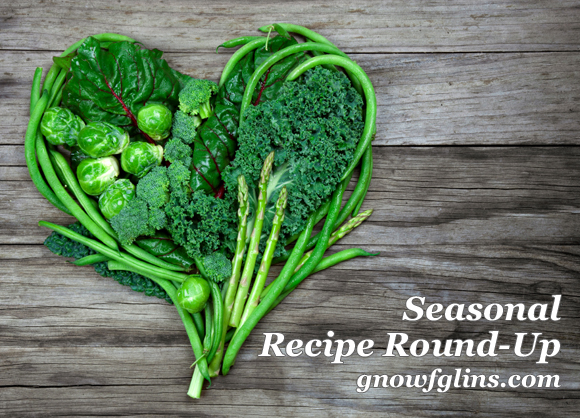
Welcome to another Seasonal Recipe Round-Up! This time we’re featuring cucumbers (and next time are berries — see schedule below). I’m sharing my tips about cucumbers and you can participate by sharing your own tips and/or recipes in the comments.
What are Cucumbers?
Cucumbers are one of the world’s most popular vegetables. Growing up around lots of Middle Eastern cuisine, I learned to love cucumbers because we ate and used them a lot! Interestingly, they are in the same botanical family as melons. There are two categories of cucumbers — slicing and pickling. The slicers are not as well suited for pickling (thicker skins and they don’t stay so crisp).
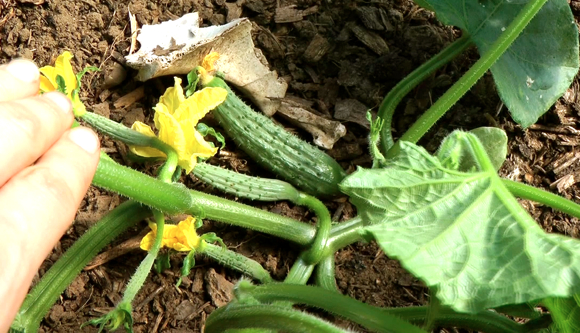
How to Choose and Prepare Cucumbers
Which cucumbers you choose depends on your goal. If you’re wanting to pickle them, definitely go for the picklers. Your results will be so much better. Fresh-eating cucumbers (called slicing) have thicker skins and usually you’ll find the larger ones need peeling or else the skin sticks in your teeth. (There are exceptions, however.)

For pickling, harvest your picklers just before usage for the crispest, best results. An ice water bath can help perk up cucumbers for any purpose. In both my online fermenting class and my book, The Complete Idiot’s Guide to Fermenting Foods, I share how to get crisp pickles. I just mentioned one tip — use fresh pickles. Another tip I learned from my friend Sylvia Britton, The Christian HomeKeeper: cut off the blossom end because enzymes in it make mushy pickles. Finally, include something with tannins in your pickles (like oak leaves or black tea).
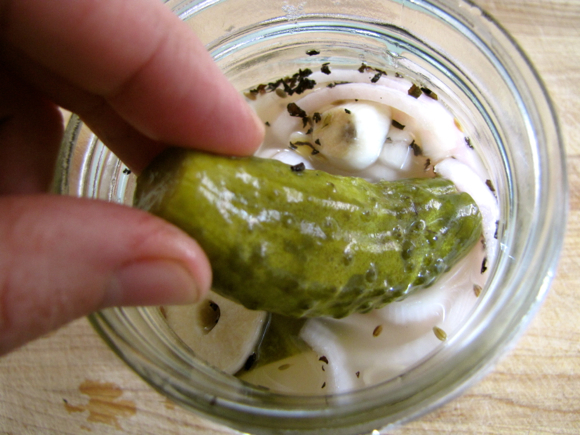
Cucumbers for fresh eating can be picked and kept in cold storage for some time before eating — a week or two at least. Skinning is the real question here. To decide whether to skin or not, I first inspect the skin. If it is on the thick side, it goes. No one wants skin in their teeth. Or if it is a dish where the skin doesn’t go with the rest of the dish’s texture (like a cucumber yogurt salad or a cold cucumber soup), I skin the cukes. For a sandwich or otherwise “crunchy” dish, a thinner skin is just fine.

Also keep in mind that larger cucumbers have larger seeds — making de-seeding something you might consider. No one wants seeds in their teeth, either!
How to Eat Cucumbers
From sandwiches and salads to cold soups, cucumbers fit in all over. Many cuisines in the world include them. I am mostly familiar with how they are used in Mediterranean dishes — usually fresh and often paired with yogurt, cheese, mint, lemon, dill, and olive oil. Delicious!
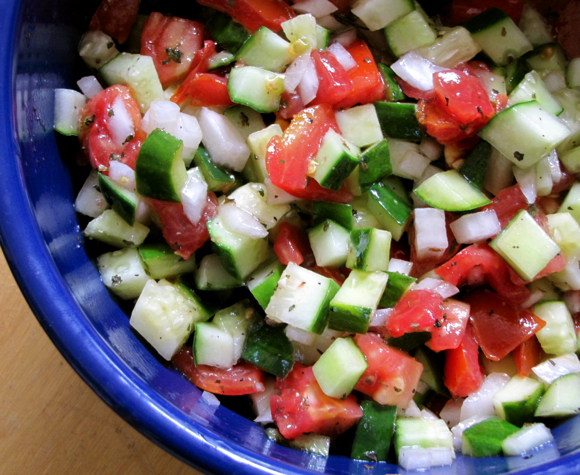
You can see my favorite cucumber recipes in the post 6 Delicious Dishes from Cucumbers, including salads, sandwiches, and pickles. Click here to check those out.
How do you eat or prepare cucumbers? Got any tips to share? 🙂 It is your turn!
How to Participate in the Seasonal Recipe Round-Up
Bloggers and non-bloggers, feel free to add a comment here with your favorite recipes or posts.
Please use real, whole ingredients in recipes, and preferably traditional methods of preparation. Whole ingredients means whole grains, vegetables, legumes, meats, and unrefined sweeteners. In order to keep the integrity of “nourishing” food, I will delete any recipes that use processed, boxed foods. Where possible, incorporate traditional methods of preparation, like soaking, sprouting and fermenting. The idea here is that your recipes and tips should help our readers find traditional methods for preparing seasonal vegetables.
Share Your Cucumber Recipes and Tips!
Seasonal Recipe Round-Up Schedule: July through August
Remember, the round-ups don’t close — you can add your recipes at any time. And I hope you will!
- Friday, July 6, 2012 — Snap Peas
- Friday, July 20, 2012 — Cucumbers
- Friday, August 3, 2012 — Berries
- Friday, August 17, 2012 — Tomatoes
- Friday, August 31, 2012 — Squash
All seasonal recipe round-ups are (and will be) listed on the Recipes page.
Come back on Friday, August 3 for our berries link-up in the Seasonal Recipe Round-Up.
...without giving up the foods you love or spending all day in the kitchen!
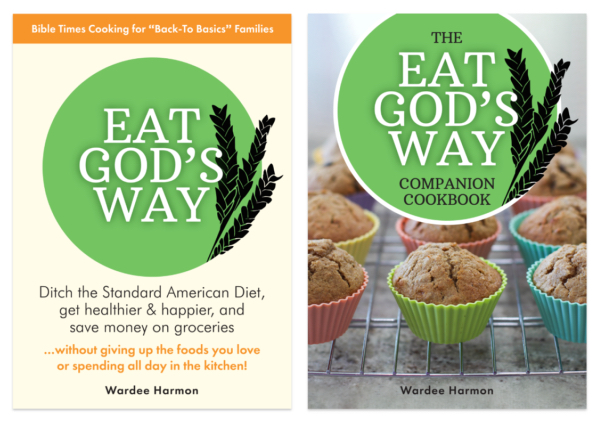
2 free books:
Eat God's Way
Ditch the Standard American Diet, get healthier & happier, and save money on groceries...
We only recommend products and services we wholeheartedly endorse. This post may contain special links through which we earn a small commission if you make a purchase (though your price is the same).


I love cucumbers. A diet I was on that only allowed me to snack on cucumbers or celery got me addicted. My “recipe” is super simple. Thinly slice the cucumbers. Drizzle some citrus infused olive oil (I use Temecula lemon, lime, or blood orange Olive Oil) but please note it has to be GOOD olive oil. Not just the regular stuff you cook with. Then some salt and pepper and omg I could eat them all day!!! If you don’t want the olive oil, use a little lime or lemon juice then salt and pepper. love love love!
Love the cucumber, tomato mint and feta salad!
HOW TO PICKLE CUCUMBERS – The Isreaeli way
(ALSO CABBAGE*, CAULIFLOWER*, CARROTS & CELERY)
TOOLS
A glass or plastic jar (2-3 liters, a plastic bottle is also a possibility), a 200 cc glass, a teaspoon and a sharp knife.
INGREDIENTS
1. 2-3 kilos of small, hard cucumbers.
2. 3-4 red hot peppers or red chili peppers.
3. 3 seeds of English pepper.
4. 1/2 a head of garlic or 4-6 garlic cloves.
5. Celery root and leaves (1 big) – a must!
6. 1/2 a package of dill leaves.
7. Cooking salt.
8. 3/4 glass of 5% citrus vinegar.
9. 4 bay leaves.
10. A spoon of mustard seeds.
PREPARATION (CUCUMBERS)
Soak in water for at least an hour before preparation. At the bottom of the jar, place a 1/3 of the hot peppers, the English pepper seeds, half of the garlic head (no need to peel it). Peel the celery root and slice it thickly (1cm each slice), then place 2 of the slices at the bottom of the jar and add the bay leaves.
1. Arrange the cucumbers vertically in the jar (it saves space that way).
2. At this stage add another 1/3 of the hot peppers and a few celery (3-4) celery leaves + the stem. Continue arranging the cucumbers.
3. Put the other half of the garlic head in the jar, together with the last 1/3 of the hot peppers and the last celery slice, and continue to arrange the cucumbers.
4. Now spread the mustard seeds and at the top of the jar, arrange the dill leaves in a circle.
5. The secret to success is in the correct salt-water ration, which is: one full teaspoon of salt for each glass of water until the jar is full and the add the vinegar.
6. The jar must be placed in a shaded place and the cucumbers will be ready in 3-4 days. It’s recommended to taste the cucumber water once in a while and, if possible, turn the jar upside-down.
7. When the liquid is thick, take out the dill. The jar must be kept in the refrigerator when the cucumbers are ready.
PREPARATION OF OTHER VEGETABLES
1. Cut the cabbage into 8 parts but keep them joined in the middle.
2. Break the cauliflower into small flowers.
3. Cut the carrots into halves and then into strips.
4. The celery should be cut into small pieces (2-4 cm).
*The cabbage and the cauliflower must be soaked twice in boiling water, for 3 minutes each time (to extract their bitterness) and the amount of vinegar should be twice that needed for the cucumbers. Also add a 1/4 teaspoon of turmeric for a yellow color.
The rest is the same as the cucumbers.
Bon appétit, Eli Rosenblit
I like to use shredded cucumbers in a tzaziki sauce, and then use some sliced cucumber, tomatoes, lettuce, shredded carrots, feta cheese, and hummus in a pita with the sauce for a healthy veggie gyro.